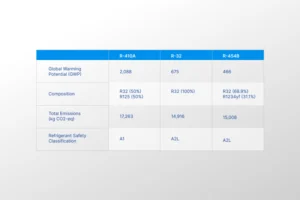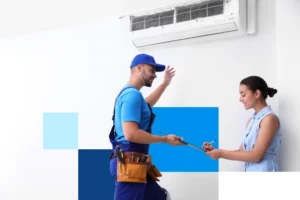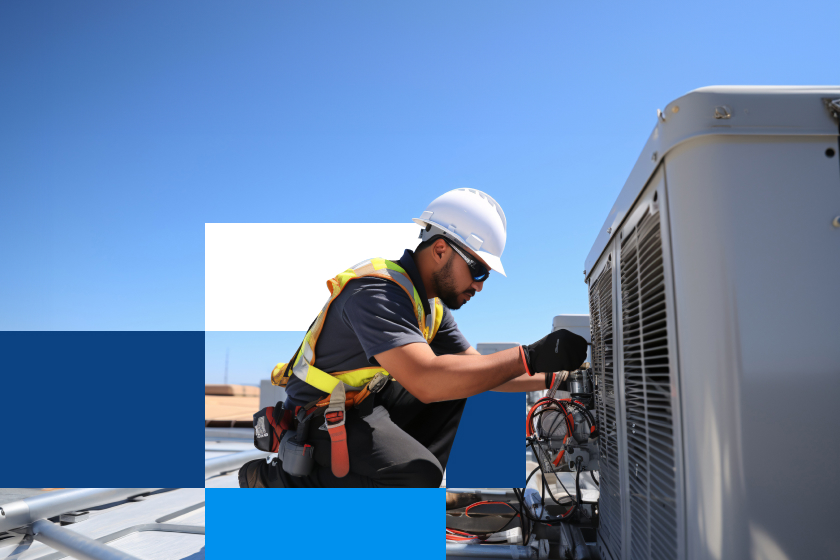In 2025, the HVAC industry will experience a major transformation with the introduction of new refrigerant changes. The Environment Protection Agency (EPA) has set new guidelines for global warming potential (GPW) limits to make way for more eco-friendly alternatives for air conditioning.
As a result, high-GWP refrigerants like R-410A are being phased out. Instead, residential systems will adopt refrigerants such as R-32 or R-454B, both of which have significantly lower impact on the environment.
Although this move is designed to reduce greenhouse gas emissions, it also brings challenges and opportunities for homeowners across the U.S. How will these changes affect your current HVAC system? Will you need to upgrade or replace parts to stay compliant? What can you do to maintain efficiency while adapting to this transition?
Here, in this blog, you will get answers to all your questions and practical tips to keep your home efficient, compliant, and climate-conscious.
Table of Contents
-
-
- An Overview of the New EPA Refrigerant Regulations 2025
- Comparison of R-32 and R-454B Refrigerants with R-410A
- Impact of the New Refrigerant Changes on the Environment
- How will this HVAC Refrigerant Change Phaseout Affect Homeowners?
- Will R-32 and R-454B be more expensive than R-410A?
- Should you replace your HVAC System now or wait?
- How to be Prepared for this HVAC Refrigerant Mandate?
- Final Thoughts
-
An Overview of the New EPA Refrigerant Regulations 2025?
The EPA is rolling out new refrigerant regulations under the American Innovation and Manufacturing (AIM) Act. The rules will bring significant changes to the HVAC industry as it aims to reduce the use of hydrofluorocarbons (HFCs), which are high-global-warming-potential refrigerants like R-410A.
Starting January 1, 2025, manufacturing or importing products using refrigerants with a GWP of 700 or higher will no longer be allowed in specified sectors. There is a grace period: systems using these refrigerants can still be installed until January 1, 2026, as long as their components are produced or imported before the 2025 deadline.
Key Highlights of the Regulations:
-
- Older Refrigerants Phase-Out: It aims to cut greenhouse gas emissions by replacing R-410A with lower-GWP options like R-454B and R-32.
- Higher Efficiency Standards: New HVAC units must meet stricter energy usage rules for better performance.
- Changes for Manufacturers: Companies have to adjust their production lines, redesign systems, train technicians, and adopt new installation practices.
Comparison of R-32 and R-454B Refrigerants with R-410A
Refrigerant is the lifeblood of your HVAC system, absorbing and releasing heat as it transitions between low-pressure gas and high-pressure liquid. R22 was the standard refrigerant for decades, but R-410A replaced it in the ’90s because of its lower ozone depletion potential.
Now, with R-410A being phased out, the industry is shifting to new, greener refrigerants like R-32 and R-454B. These A2L-class options offer lower global warming potential, making them a better choice for the environment while maintaining the cooling efficiency you expect.

Impact of the New Refrigerant Changes on the Environment
The 2025 refrigerant changes are a step toward more environmentally friendly and energy-efficient HVAC solutions. The use of low-GWP refrigerants like R-454B and R32 brings the following environmental benefits:
A Cleaner Choice for the Environment
-
- R-410A has been the go-to refrigerant for years, but its high GWP takes a toll on the environment. Switching to R-454B, with its 65% lower GWP, helps cut down on greenhouse gas emissions and makes HVAC systems much more eco-friendly.
Energy Efficient
-
- The new HVAC refrigerants for 2025 are designed to run more efficiently, using less electricity to keep your home cool. Lower energy use means power plants burn fewer fossil fuels, cutting down on carbon emissions. Well, for homeowners, that’s a win-win: saving money while helping the planet breathe a little easier.
Complying with Global Climate Agreements
-
- New refrigerant regulations are part of a worldwide effort to phase out HFCs under agreements. These gases are potent contributors to global warming, and transitioning to greener alternatives will help reduce their impact on the environment.
How will this HVAC Refrigerant Change Phaseout Affect Homeowners?
With the new refrigerant changes rolling out, if you’re wondering how they will impact your older HVAC system, you’re not alone. Let’s break down what this phaseout means for homeowners like you.
Keeping older systems running will be tough in the future
-
- If your system uses R-410A or an older refrigerant, you don’t need to replace it right away. However, over time, R-410A will be harder to find, driving up repair costs. A refrigerant leak could mean much steeper expenses for refilling your system.
Compatibility issues with older systems
-
- Unfortunately, most older HVAC units don’t work with the new refrigerants. While retrofitting is an option, it can cost a lot and isn’t always worth it. Moreover, if your system is nearing the end of its life, a full replacement might make more sense.
Upgrading to systems with new refrigerants
-
- If you are planning to replace or install a new HVAC system, the updated regulations mean your new unit will use R-454B or another low-GWP refrigerant. These systems are built to meet the latest standards, making them more energy-efficient and environment-friendly.Switching to eco-friendly refrigerants can feel a little overwhelming. What does it mean for your home, your system, or the environment? We are here to help by answering the most common questions you have.
Will R-32 and R-454B be more expensive than R-410A?
With regulatory updates, new refrigerants and upgraded components are a must to meet the standards, and that can influence market prices. So, expect 2025-compliant systems to cost a bit more since they are built with advanced technology to have a lower impact on the environment.
Should you replace your HVAC System now or wait?
There is a limited window to replace your old HVAC system before new regulations take full effect. If you hold off on replacing your HVAC system, you might end up paying a lot more. After December 31, 2024, new systems must comply with EPA standards and could cost up to 20% to 30% more in 2025. Hence, acting now is a smart move.
How to be Prepared for this HVAC Refrigerant Mandate?
Now that the 2025 EPA refrigerant changes are already underway, here are some easy steps to ensure your home is fully prepared for the transition.

-
- Schedule an Inspection: To stay ahead, have an HVAC technician assess your system’s refrigerant and overall performance. If you are using an older model with R-410A or R-22, it could be a good time to start considering an upgrade. With the 2025 refrigerant changes already in effect, it will be harder and more costly to maintain older systems.
- Take Advantage of Incentives: Many states are offering rebates and incentives for homeowners upgrading to energy-efficient HVAC systems. So, make sure to ask your HVAC advisor about any current state programs that can help lower the cost of your new system.
- Choose a Reliable Professional – With these changes coming, it is helpful to have an expert on your side. You should find a trusted HVAC professional who can guide you through upgrading your system to meet the new refrigerant standards.
Unexpected HVAC issues? No worries! Our warranty plans ensure you are covered for repairs and replacements. Have questions? Call us at
800-670-8931 today!
Final Thoughts
With the new refrigerant changes, upgrading to R-32 or R-454B ensures you stay compliant with the new regulations. Most importantly, it is a step towards building an energy-efficient, eco-friendly, and future-ready home. While the upfront costs might be higher, the long-term savings and positive environmental impact make this upgrade a wise decision for any homeowner.

